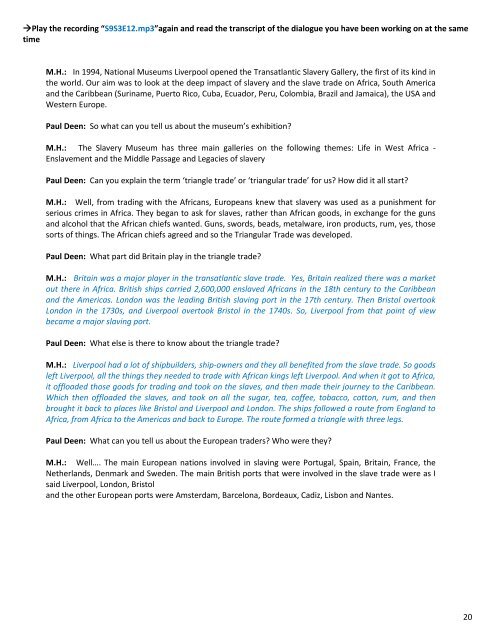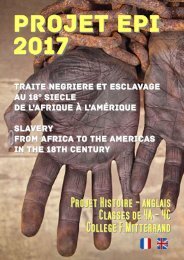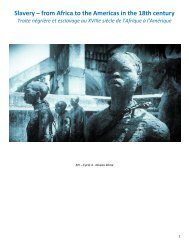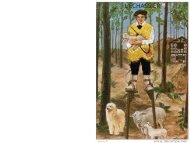EPI - Slavery – from Africa to the Americas 2017
Create successful ePaper yourself
Turn your PDF publications into a flip-book with our unique Google optimized e-Paper software.
Play <strong>the</strong> recording “S9S3E12.mp3”again and read <strong>the</strong> transcript of <strong>the</strong> dialogue you have been working on at <strong>the</strong> same<br />
time<br />
M.H.: In 1994, National Museums Liverpool opened <strong>the</strong> Transatlantic <strong>Slavery</strong> Gallery, <strong>the</strong> first of its kind in<br />
<strong>the</strong> world. Our aim was <strong>to</strong> look at <strong>the</strong> deep impact of slavery and <strong>the</strong> slave trade on <strong>Africa</strong>, South America<br />
and <strong>the</strong> Caribbean (Suriname, Puer<strong>to</strong> Rico, Cuba, Ecuador, Peru, Colombia, Brazil and Jamaica), <strong>the</strong> USA and<br />
Western Europe.<br />
Paul Deen: So what can you tell us about <strong>the</strong> museum’s exhibition?<br />
M.H.: The <strong>Slavery</strong> Museum has three main galleries on <strong>the</strong> following <strong>the</strong>mes: Life in West <strong>Africa</strong> -<br />
Enslavement and <strong>the</strong> Middle Passage and Legacies of slavery<br />
Paul Deen: Can you explain <strong>the</strong> term ‘triangle trade’ or ‘triangular trade’ for us? How did it all start?<br />
M.H.: Well, <strong>from</strong> trading with <strong>the</strong> <strong>Africa</strong>ns, Europeans knew that slavery was used as a punishment for<br />
serious crimes in <strong>Africa</strong>. They began <strong>to</strong> ask for slaves, ra<strong>the</strong>r than <strong>Africa</strong>n goods, in exchange for <strong>the</strong> guns<br />
and alcohol that <strong>the</strong> <strong>Africa</strong>n chiefs wanted. Guns, swords, beads, metalware, iron products, rum, yes, those<br />
sorts of things. The <strong>Africa</strong>n chiefs agreed and so <strong>the</strong> Triangular Trade was developed.<br />
Paul Deen: What part did Britain play in <strong>the</strong> triangle trade?<br />
M.H.: Britain was a major player in <strong>the</strong> transatlantic slave trade. Yes, Britain realized <strong>the</strong>re was a market<br />
out <strong>the</strong>re in <strong>Africa</strong>. British ships carried 2,600,000 enslaved <strong>Africa</strong>ns in <strong>the</strong> 18th century <strong>to</strong> <strong>the</strong> Caribbean<br />
and <strong>the</strong> <strong>Americas</strong>. London was <strong>the</strong> leading British slaving port in <strong>the</strong> 17th century. Then Bris<strong>to</strong>l over<strong>to</strong>ok<br />
London in <strong>the</strong> 1730s, and Liverpool over<strong>to</strong>ok Bris<strong>to</strong>l in <strong>the</strong> 1740s. So, Liverpool <strong>from</strong> that point of view<br />
became a major slaving port.<br />
Paul Deen: What else is <strong>the</strong>re <strong>to</strong> know about <strong>the</strong> triangle trade?<br />
M.H.: Liverpool had a lot of shipbuilders, ship-owners and <strong>the</strong>y all benefited <strong>from</strong> <strong>the</strong> slave trade. So goods<br />
left Liverpool, all <strong>the</strong> things <strong>the</strong>y needed <strong>to</strong> trade with <strong>Africa</strong>n kings left Liverpool. And when it got <strong>to</strong> <strong>Africa</strong>,<br />
it offloaded those goods for trading and <strong>to</strong>ok on <strong>the</strong> slaves, and <strong>the</strong>n made <strong>the</strong>ir journey <strong>to</strong> <strong>the</strong> Caribbean.<br />
Which <strong>the</strong>n offloaded <strong>the</strong> slaves, and <strong>to</strong>ok on all <strong>the</strong> sugar, tea, coffee, <strong>to</strong>bacco, cot<strong>to</strong>n, rum, and <strong>the</strong>n<br />
brought it back <strong>to</strong> places like Bris<strong>to</strong>l and Liverpool and London. The ships followed a route <strong>from</strong> England <strong>to</strong><br />
<strong>Africa</strong>, <strong>from</strong> <strong>Africa</strong> <strong>to</strong> <strong>the</strong> <strong>Americas</strong> and back <strong>to</strong> Europe. The route formed a triangle with three legs.<br />
Paul Deen: What can you tell us about <strong>the</strong> European traders? Who were <strong>the</strong>y?<br />
M.H.: Well…. The main European nations involved in slaving were Portugal, Spain, Britain, France, <strong>the</strong><br />
Ne<strong>the</strong>rlands, Denmark and Sweden. The main British ports that were involved in <strong>the</strong> slave trade were as I<br />
said Liverpool, London, Bris<strong>to</strong>l<br />
and <strong>the</strong> o<strong>the</strong>r European ports were Amsterdam, Barcelona, Bordeaux, Cadiz, Lisbon and Nantes.<br />
20

















